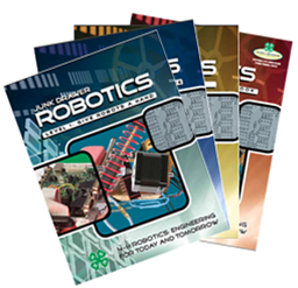Junk Drawer Robotics introduces students to robotics using 4-H’s experiential learning methodology. (See my general review of 4-H here.) It should be great fun since students make many creative projects.
This is a course that really should be done with a group since it requires lots of resources that would be a bother to gather for only one student, plus many projects are used in games and team competitions. In addition, the creativity of various members of the group is likely to encourage and challenge students in ways not possible with a single student working alone.
Junk Drawer Robotics has three levels that should be used consecutively. According to 4-H, all levels should be appropriate for students in grades four through twelve. However, I think there are math and logic concepts that are likely to be very challenging for fourth and fifth graders, concepts such as calculating gear ratios and the logic gates used in binary and electrical circuits with their symbols and “truth tables.” There is some math involved, and students will collect and analyze a good deal of data from their observations and experiments.
Junk Drawer Robotics uses many resources, although most of them are likely to be around the house already, probably in a tool box, craft supplies cupboard, a junk drawer, or the garage. You will need to collect some items such as paper, plastic cups, tape, and wrapping paper tubes on your own. A Level 1 Kit (with supplies for ten students) includes many items you will need such as ping pong balls, binder clips, wooden clothespins, plastic canvas, brass brads, paper clips, bamboo skewers, large craft sticks, paint stirring sticks, syringes, “airline” tubing, and balloons. The Level 2 Kit (for ten students) uses some of the same items as does Level 1 but it also includes items such as battery holders, miniature bulbs, gears, a disk magnet, small motors, a small plastic propeller, geared wheels, narrow wheels, wide wheels, copper wire, and worm gears. A Facilitator’s Kit puts some basic equipment together for you that will be used with all levels, items such as hacksaw blades, a hand drill with bits, a hot glue gun, jeweler’s pliers, and goggles. (Complete lists of what is included in each kit are on the website, so you can check to see what you already have and decide whether you need the kits or only selected items.) The website doesn’t show a kit for Level 3, but I hope that is in the works since that level requires a small electronics kit (for resistors, LEDs, capacitors, IC chips, etc.) as well as batteries, motors, and gears. None of the items are very expensive. You could probably take your list to an electronics store and pick up the more challenging items in one shopping trip.
Level 1: Give Robots a Hand begins with some preliminary activities to help students “think like a scientist, communicate like an engineer, and build like a technician.” The first module culminates with students working in teams to build a marshmallow catapult. The second module introduces robotics as students explore and build a robotic arm then apply pneumatic technology to make it move. In the last module of Level 1, students add gripper and wrist designs to their robotic arms. Five to seven activities within each module help students gradually develop the knowledge and skills that they need.
Level 2: Robots on the Move has four modules. In the first module, students work with wheels and friction, and they build a complex “clipmobile.” The second module is an exploration of electrical circuits that culminates with students building a very simple, motor-operated robot out of a plastic cup. Next, students learn to work with gears to build a rover with a gear train that can climb a ramp. The final module has them build a remotely operated vehicle that can move in water, including going underwater and rising again.
Level 3: Mechatronics expands to five modules. The first two modules explore electrical circuits and switches as students build a reverse switch and a wall-following robot. The next two modules shift into computer logic. While students don’t actually work on computers, the modules teach them about programming logic and flowcharts while students also build complex circuit boards. These modules have some super creative games and activities that help teach the logic and programming. If you are able to have students begin work in a programming language, this would be the time to do so, but Junk Drawer Robotics doesn’t provide instruction for actually using the computer. The fifth and final module of the course has students design and build their own robot to perform a particular task of their choosing.
Many of the lessons have students go back and evaluate their projects, sometimes working on them to make improvements. This reflects real-world science and technology where changes and improvements are an important part of the process.
A single Youth Robotics Notebook is used by a student as he or she works through all three levels. Students will write answers to questions in here along with drawings, and data recording. Each student will need his or her own Notebook.
Junk Drawer Robotics should be an inspiring introduction to robotics. Each module within a level breaks the learning and activities down into segments that can be completed in 20 or 40 minutes. It seems to me that you could plan to complete one or two segments per class session with classes meeting once or twice a week. With 19 segments in each of the first two levels and 21 in the third, it seems entirely possible that you could complete all three levels within one school year, but that would probably be the minimum time it would take. Students should love this course, and I expect that teaching Junk Drawer Robotics will probably be as much fun as taking the course.








